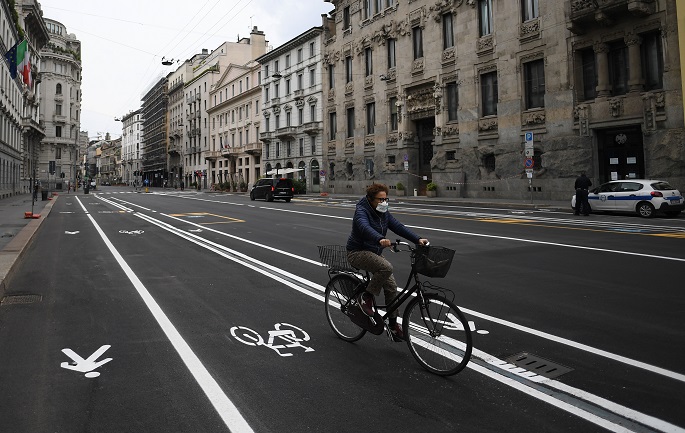Coronavirus claims over 29,000 lives
Italy enters new phase after lockdown
Published : 04 May 2020, 20:27
Updated : 04 May 2020, 23:58
The coronavirus pandemic has claimed over 29,000 lives in Italy, bringing the total number of infections, fatalities and recoveries to 211,938 as of Monday, according to the latest data released by the country's Civil Protection Department.
The death toll on Monday was 195, bringing the nationwide fatalities to 29,079 since the pandemic first broke out in the northern Lombardy region. Total active infections stood at 99,980, with a decrease of 199 cases compared to the previous day.
Monday saw 1,221 new coronavirus infections and 1,225 additional recoveries compared to Sunday, bringing the nationwide totals to 211,938 and 82,879, respectively.
Of those infected, 1,479 are in intensive care -- down by 22 compared to Sunday, and 16,823 are hospitalized in normal wards -- down by 419. The remaining 81,678 people, or 81.7 percent of those who tested positive, are in isolation at home.
LOCKDOWN EASED
Italians enjoyed more liberties on Monday, as some restrictions on productive activities and personal movements were relaxed for the first time after almost eight weeks.
Overall, some 4.4 million people went back to work, adding to those employed in essential economic sectors -- such as food industry, supermarkets, and transports -- who never stopped during the lockdown that had entered into force on March 10.
Companies in manufacturing, construction, and wholesale sectors could resume work, provided they ensured strict compliance with workplace safety protocols.
Bars and restaurants were allowed to reopen for takeaway services instead of delivery only as during the lockdown.
And new rules allowed Italians to visit family members (but not friends) living in the same region, to move across their city, and to practice sporting activities outdoor and in public parks, but alone.
Local media paid wide attention to how people approached this so-called "Phase Two" of the emergency, which Prime Minister Giuseppe Conte and several other authorities have warned will be ever more sensitive than the first phase of the pandemic.
In Milan, Rome, Naples, Florence and Turin, limited rush hours were reported in the early morning.
People were often seen queueing shortly outside bars to buy takeaway espressos and light lunches, while temperature checks were carried out in train stations on passengers traveling for the first time from region to region out of essential reasons -- such as in the first high-speed train that reached southern Naples from northern Milan on early Monday.
The airports of Ciampino in Rome (the second largest in the capital after Fiumicino) and Peretola in Florence (the second largest in Tuscany after Pisa) also resumed their activity on Monday, as announced by the Transport Ministry last Thursday.
Overall, most of the air traffic in Italy stopped when the lockdown entered into force, with the number of passengers dropping by some 85 percent (almost 12 million people) in March, according to Italy's association of airports operators Assaeroporti.
During this second phase of the emergency, public transports in Rome, Milan, and Naples -- the country's three largest metropolitan areas, respectively -- will especially be in the spotlight.
Wearing face masks has become compulsory for entering buses and metro, and the local transport companies are required to implement the necessary measures to ensure that passengers keep a safe distance between each other.
Yet, for the three major cities at least, doubts remained on whether transport networks have been developed enough to ensure the required safety distance, considering the number of commuters now allowed to moving again.
The task force coordinated by the Civil Protection distributed 26.7 million face masks in the past week, and a total of 165.5 million since the beginning of the emergency, according to Italy's procurement commissioner for the coronavirus emergency Domenico Arcuri.
MORTALITY IMPACTED HARD BY VIRUS
In a separate joint report on Monday, Italy's National Health Institute (ISS) and National Institute of Statistics (ISTAT) stated the number of deaths for all causes in the country increased by 49.4 percent in March compared to the same period in the years 2015-2019.
The jump in mortality was largely ascribed to the impact of the coronavirus.
"Taking as a reference the period between the first fatality for COVID-19 (the disease caused by the coronavirus), reported to the Integrated Surveillance System (Feb. 20) and March 31, deaths grew from 65,592 (average in the period 2015-2019) to 90,946 in 2020," the report said.
"There are 25,354 fatalities in excess, of which some 54 percent are made by COVID-19 diagnosed deaths (13,710)," it added.
ISS and ISTAT warned that -- due to the pandemic hitting some areas (in north and center) much more than others (in south) -- "the data reported at national average level flatten the size of the impact of the COVID-19 epidemic on total mortality."


